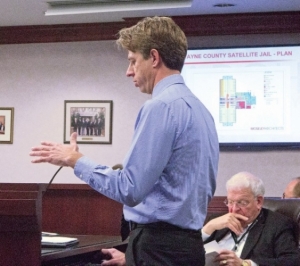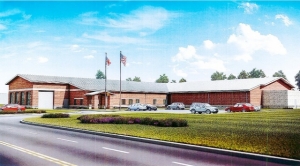Jail plan picked
By Steve Herring
Published in News on November 19, 2014 1:46 PM

News-Argus/STEVE HERRING
Jason Hopkins, left, with Moseley Architects of Charlotte, explains the design of a proposed $10 million 217-bed misdemeanant jail Tuesday to Wayne County commissioners as County Attorney Borden Parker, right, looks over the documents.

This is a rendering of the design for the $10 million 217-bed misdemeanant jail that was approved Tuesday morning by Wayne County commissioners. The entrance to the T-shaped building is by the flags. At the top right is one of the two cell pods that would make up the top of the T.
Construction of a $10 million, 217-bed misdemeanant jail on North William Street will not require a property tax increase, County Manager George Wood said Tuesday.
Wood made his comments prior to Wayne County commissioners voting to accept the schematic design for the jail and authorizing the project architect, Moseley Architects of Charlotte, to proceed with the full design.
The board did not authorize money to build the jail, but approved a $692,876 budget amendment, which is part of the $10 million, for the project, which includes $630,326 for architectural, engineering and design fees based on 7 percent of construction cost and $62,500 for operations and transition planning services.
That figure is subject to change depending on the final construction cost, which is expected to be about $9 million.
An additional $972,966 will be required for fixtures, computers, furniture, site and construction testing, design costs and document printing.
Moseley's Dan Mace said the hope is to bid out the project in March or April. He anticipates the final cost will be less than the projected $9.9 million.
Commissioner Joe Daughtery said he hopes it will be much lower.
As planned, the misdemeanant jail would be the first phase of a larger judicial center project that would be built on county-owned property on North William Street where the old Masons department store building now stands.
The design components include a site plan showing the smaller jail, a larger area behind it reserved for the main jail to be constructed later, exterior views of the building and a detailed interior floor plan.
It would be a single-story facility, containing about 37,000 square feet of floor space.
The design shows a T-shaped misdemeanant jail with the top of the T, where the cell pods would be located, running parallel to Stronach Avenue.
The leg of the T, which would house administration, the kitchen, laundry and other offices, would be perpendicular to Stronach Avenue with a secure, controlled entryway facing that street.
Each pod would have a fenced-in recreational yard.
"Understand that we are still at the schematic design level," Mace said. "As we move forward into the development and contract document phase, this estimate that you see here will be much more detailed. The next one that you see at the conclusion of the design development phase will be like a contractor.
"So it will be a very detailed cost estimate. Again, the more detail we get on the project as it moves forward, the better snapshot we get of what the building will probably cost."
Mace noted that the initial cost includes nearly $1 million in contingency funding. He said he expects to see that cost decrease as more exact figures become available.
"Again, I want to give you an estimate that I feel is conservative," Mace said. "We don't want to come back to commissioners and say, 'Oh, by the way, we need more money.'"
Daughtery said some people had asked why commissioners had not used the design/build method that had saved money on the Steele Memorial Library project in Mount Olive.
"I think the answer here is that (the jail) is such a specialized type of construction that we really need to have an architect that is familiar with it as well as a contractor," he said.
Wood said that was correct and that he would not have recommended using design/build for the jail.
Very few architects specialize in jail construction, but Mosley has done about a third of the jails in the state, he said.
A motion by Commissioner John Bell, who serves as chairman of the commission's Jail Advisory Committee, was unanimously approved.
Wood described how the jail would be paid for.
"If you remember, you set aside, out of fund balance, $5 million toward the jail project," Wood said. "That is already shown as committed in our fund balance."
Not counting county school projects, the current county debt service will be paid off within four years, Wood said. The $5 million would be used to bridge those four years, he said.
Wood said he expects that would take only about $3 million of the $5 million.
"We won't have extra money to pay the debt (on the jail) the first four years because we will still have to make these (current debt) payments," he said.
However, starting in fiscal year 2020, the county will have approximately $1.1 million to use because the existing debt service will be paid off, he said.
"Then we have the money to more than make these payments because these annual (jail) payments at that point will be $800,000 and we will have $1.1 million to meet that," Wood said. "So what I am telling you is that we are going to be able to build this jail without having to change any tax rates or anything else."
Along with the cost of the jail, the county has to be prepared to cover additional operating costs, he said.
The county will be able to more than cover those costs with the $1 million saved from not having to house inmates in other counties because of overcrowding at the current jail, Wood said.
One cent on the county property tax rate equals roughly $750,000, Daughtery said.
"I am just hoping that we can come substantially below your estimates," he told Mace.
Commissioner Bill Pate asked if salvageable materials, such as steel, could be sold when the existing buildings on the William Street site are demolished.
Mace said that could be made part of the contract that the contractor could salvage the materials and in doing so that would reduce the cost of the demolition.
